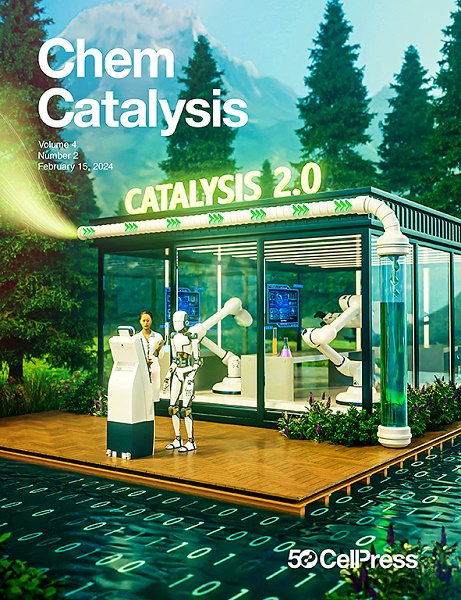Polyaniline-supported copper nanocrystals for electrochemical CO2 reduction to methane
IF 11.6
Q1 CHEMISTRY, PHYSICAL
引用次数: 0
Abstract
Achieving industrial electrochemical CO2 reduction necessitates the strategic design of electrocatalysts with high activity, superior selectivity, and excellent stability. Herein, we developed spatially dispersed copper nanocrystals supported by polyaniline (PANI-CuNCs) for electrochemical CO2 reduction, achieving a faradaic efficiency of 68.6% ± 2.2% toward methane at −300 mA cm−2. The chelation of the Cu precursor within the oxidized emeraldine base (EB) is crucial for forming isolated CuNCs. The PANI substrate facilitates proton shuttling to Cu(111) sites, enhancing methane production by promoting protonation and reducing ∗CO coverage. In situ Raman and theoretical calculations show that PANI improves CO2 adsorption and activation by creating a hydrophilic environment, highlighting its potential for industrial CO2 reduction electrocatalysis. Our work introduced a promising strategy that utilizes polymers as substrates to prepare well-dispersed NCs for electrocatalysis, highlighting the potential of such systems in advancing the field of industrial electrochemical CO2 reduction.

聚苯胺负载的铜纳米晶电化学CO2还原为甲烷
实现工业电化学CO2还原需要战略性地设计具有高活性、高选择性和优异稳定性的电催化剂。在此,我们开发了聚苯胺负载的空间分散铜纳米晶体(PANI-CuNCs)用于电化学CO2还原,在- 300 mA cm - 2下对甲烷的法拉第效率为68.6%±2.2%。铜前驱体在氧化祖母绿碱(EB)内的螯合作用是形成分离的Cu的关键。聚苯胺底物促进质子穿梭到Cu(111)位点,通过促进质子化和降低∗CO覆盖来增加甲烷的产生。原位拉曼和理论计算表明,聚苯胺通过创造亲水性环境来改善二氧化碳的吸附和活化,突出了其在工业二氧化碳还原电催化方面的潜力。我们的工作介绍了一种很有前途的策略,即利用聚合物作为底物来制备分散良好的纳米碳纳米管用于电催化,突出了这种系统在推进工业电化学二氧化碳还原领域的潜力。
本文章由计算机程序翻译,如有差异,请以英文原文为准。
求助全文
约1分钟内获得全文
求助全文
来源期刊
CiteScore
10.50
自引率
6.40%
发文量
0
期刊介绍:
Chem Catalysis is a monthly journal that publishes innovative research on fundamental and applied catalysis, providing a platform for researchers across chemistry, chemical engineering, and related fields. It serves as a premier resource for scientists and engineers in academia and industry, covering heterogeneous, homogeneous, and biocatalysis. Emphasizing transformative methods and technologies, the journal aims to advance understanding, introduce novel catalysts, and connect fundamental insights to real-world applications for societal benefit.

 求助内容:
求助内容: 应助结果提醒方式:
应助结果提醒方式:


